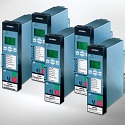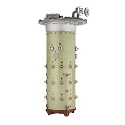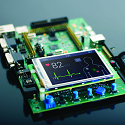Research and Development in Our Laboratory

Electrical power system operates at various voltage levels from 400 V to 400 kV or even more. Electrical components might be enclosed (e.g., motors) or placed in open area (e.g., transmission lines). Such equipment undergo abnormalities in their life time because of various reasons. It is necessary to prevent the abnormal operating regions for the safety of equipment. More important is the safety of human personnels which may be endangered due to exposure to live parts under fault or abnormal operating conditions.
Therefore, every electrical equipment has to be monitored to protect it and provide human safety under abnormal operating conditions. This job is assigned to electrical protection systems. It encompasses apparatus protection and system protection.

Intelligent electronic devices (IEDs) are microprocessor-based controllers of power system equipment. They can communicate with the automation system as well as with each other to give an overall image of what is happening to the process or power supply system. IEC 61850 communication interface can efficiently handle this data over Ethernet. Exchanging the same amount of data between plant devices using traditional communication interfaces will require huge amount of cabling.
The difficulties of electrical integration have been largely removed with the advent of IEC 61850. Acknowledged as the global communication standard in substation automation, it represents a huge step forward in simplifying the integration of protection and control IEDs.
With its standardized model of the IED and its data and communication points, IEC 61850 ensures interoperability between electrical equipment from different vendors and is able to replace all the typical protocols found in the substation automation domain. Based on Ethernet technology and providing flexible and open system architecture, IEC 61850 makes the application future-proof over entire system lifecycles.

Condition monitoring is the process of determining the condition of equipment while in operation. The key to a successful condition monitoring programme includes, knowing what to listen for, how to interpret it, and when to put this knowledge to use. Successfully using this program enables the repair of problem components prior to failure. Condition monitoring not only helps plant personnel reduce the possibility of catastrophic failure, but also allows them to order parts in advance, schedule manpower, and plan other repairs during the downtime.

Online condition monitoring systems are based on a history of data that is kept during phases of normal equipment operation. Trends of various equipment parameters are stored continously. Then, actual process deviations are compared to the historical data in equipment analysis. As a result, operators will be automatically warned about developing misfunctions and would be able to do minor repairs in the ongoing production process or the maintenance staff can prepare some works for planned (scheduled) equipment shutdowns. Thus, unplanned downtimes or total failures of equipment can be reduced and therefore heavy financial losses will be avoided by continous condition monitoring.

A smart grid is an evolved grid system that manages electricity demand in a sustainable, reliable and economic manner, built on advanced infrastructure and tuned to facilitate the integration of all involved. Smart grids will provide more electricity to meet rising demand, increase reliability and quality of power supplies, increase energy efficiency, be able to integrate low carbon energy sources into power networks. Smart grids have demand response capacity to help balance electrical consumption with supply, as well as the potential to integrate new technologies to enable energy storage devices and the large-scale use of electric vehicles. Electrical systems will undergo a major evolution, improving reliability and reducing electrical losses, capital expenditures and maintenance costs. A smarter grid will provide greater control over energy costs and a more reliable energy supply for consumers. Environmental benefits of a smarter grid include reduced peak demand, integration of more renewable power sources, and reduced CO2 emissions and other pollutants.

Embedded systems are based on microcontrollers (MCUs), and run software with a small memory footprint. In this manner, some Linux and Android-based systems can also be described as embedded systems. But usually, these general-purpose operating systems require an application processor, and have additional capabilities such as dynamic application loading. This is why MCU-based embedded systems are often described as deeply embedded systems, versus the more general definition of embedded systems.
Because an embedded system is engineered to perform certain tasks only, design engineers may optimize size, cost, power consumption, reliability and performance. Embedded systems are typically produced on broad scales and share functionalities across a variety of environments and applications. MCUs featuring 32-bit architectures have dropped in price over the last several years, and are becoming common in embedded systems. The greater capabilities of 32-bit MCUs present new choices for embedded systems developers. Today, embedded systems are found in cell phones, digital cameras, camcorders, portable video games, calculators, and personal digital assistants, microwave ovens, answering machines, home security systems, washing machines, lighting systems, fax machines, copiers, printers, and scanners, cash registers, alarm systems, automated teller machines, transmission control, cruise control, fuel injection, anti-lock brakes, active suspension and many other devices / gadgets.












